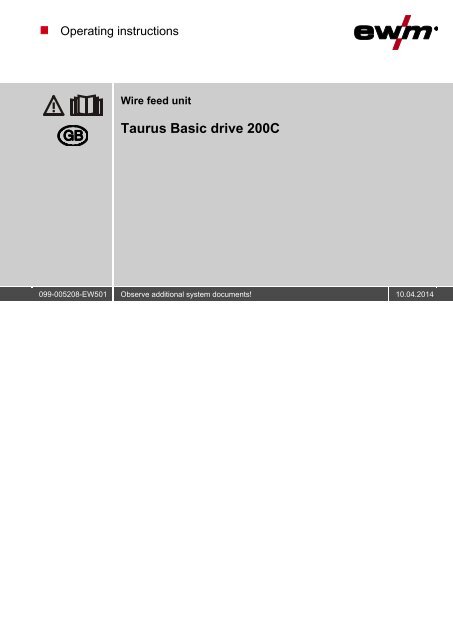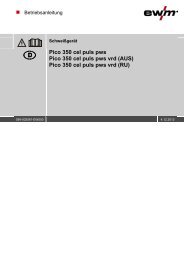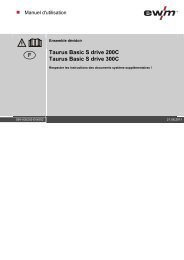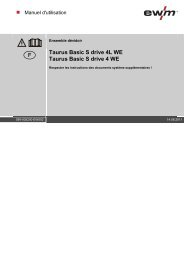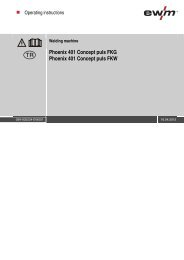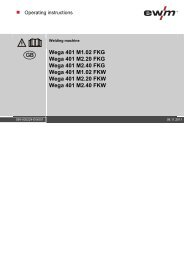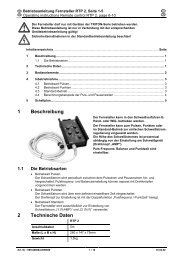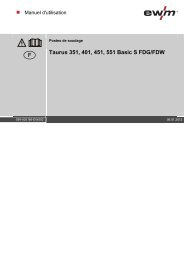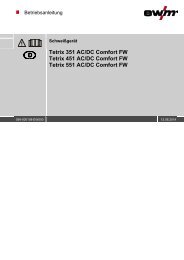Operating instructions - EWM Hightec Welding GmbH
Operating instructions - EWM Hightec Welding GmbH
Operating instructions - EWM Hightec Welding GmbH
Create successful ePaper yourself
Turn your PDF publications into a flip-book with our unique Google optimized e-Paper software.
<strong>Operating</strong> <strong>instructions</strong>Wire feed unitTaurus Basic drive 200C099-005208-EW501 Observe additional system documents! 10.04.2014
General <strong>instructions</strong>CAUTIONRead the operating <strong>instructions</strong>!The operating <strong>instructions</strong> provide an introduction to the safe use of the products.• Read the operating <strong>instructions</strong> for all system components!• Observe accident prevention regulations!• Observe all local regulations!• Confirm with a signature where appropriate.NOTEIn the event of queries on installation, commissioning, operation or special conditions at theinstallation site, or on usage, please contact your sales partner or ourcustomer service department on +49 2680 181-0.A list of authorised sales partners can be found at www.ewm-group.com.Liability relating to the operation of this equipment is restricted solely to the function of the equipment. No otherform of liability, regardless of type, shall be accepted. This exclusion of liability shall be deemed accepted by theuser on commissioning the equipment.The manufacturer is unable to monitor whether or not these <strong>instructions</strong> or the conditions and methods areobserved during installation, operation, usage and maintenance of the equipment.An incorrectly performed installation can result in material damage and injure persons as a result. For this reason,we do not accept any responsibility or liability for losses, damages or costs arising from incorrect installation,improper operation or incorrect usage and maintenance or any actions connected to this in any way.© <strong>EWM</strong> AG · Dr. Günter-Henle-Str. 8 · D-56271 Mündersbach, GermanyThe copyright to this document remains the property of the manufacturer.Reprinting, including extracts, only permitted with written approval.Subject to technical amendments.
ContentsNotes on the use of these operating <strong>instructions</strong>1 Contents1 Contents .................................................................................................................................................. 32 Safety <strong>instructions</strong> ................................................................................................................................. 52.1 Notes on the use of these operating <strong>instructions</strong> .......................................................................... 52.2 Explanation of icons ....................................................................................................................... 62.3 General .......................................................................................................................................... 72.4 Transport and installation ............................................................................................................ 112.4.1 Ambient conditions ....................................................................................................... 122.4.1.1 In operation ................................................................................................... 122.4.1.2 Transport and storage ................................................................................... 123 Intended use ......................................................................................................................................... 133.1 Applications .................................................................................................................................. 133.1.1 MIG/MAG standard welding ......................................................................................... 133.1.2 MMA welding ................................................................................................................ 133.1.2.1 Air arc gouging .............................................................................................. 133.2 Use and operation solely with the following machines ................................................................ 143.3 Documents which also apply ....................................................................................................... 153.3.1 Warranty ....................................................................................................................... 153.3.2 Declaration of Conformity ............................................................................................. 153.3.3 <strong>Welding</strong> in environments with increased electrical hazards ......................................... 153.3.4 Service documents (spare parts and circuit diagrams) ................................................ 153.3.5 Calibration/Validation ................................................................................................... 154 Machine description – quick overview .............................................................................................. 164.1 Front view .................................................................................................................................... 164.2 Rear view ..................................................................................................................................... 174.3 Inside view ................................................................................................................................... 184.4 Machine control – <strong>Operating</strong> elements ........................................................................................ 195 Design and function ............................................................................................................................. 205.1 Installation .................................................................................................................................... 215.2 <strong>Welding</strong> torch cooling system ...................................................................................................... 225.2.1 List of coolants .............................................................................................................. 225.3 Notes on the installation of welding current leads ....................................................................... 235.4 Connecting the intermediate hose package to the wire feed unit ................................................ 255.4.1 Intermediate hose package strain relief ....................................................................... 255.5 Shielding gas supply (shielding gas cylinder for welding machine) ............................................. 275.5.1 Gas test ........................................................................................................................ 275.5.2 Setting the shielding gas quantity ................................................................................. 275.6 MIG/MAG welding ........................................................................................................................ 285.6.1 <strong>Welding</strong> torch connection ............................................................................................. 285.6.2 Wire feed ...................................................................................................................... 305.6.2.1 Open the protective flap of the wire feeder ................................................... 305.6.2.2 Inserting the wire spool ................................................................................. 305.6.2.3 Changing the wire feed rollers ...................................................................... 315.6.2.4 Inching the wire electrode ............................................................................. 325.6.2.5 Spool brake setting ....................................................................................... 345.6.3 Standard MIG/MAG torch ............................................................................................. 345.6.4 MIG/MAG special-torches ............................................................................................ 345.6.5 <strong>Welding</strong> task selection .................................................................................................. 355.6.5.1 Accessory components for operating point setting ....................................... 355.7 Remote control ............................................................................................................................. 366 Maintenance, care and disposal ......................................................................................................... 376.1 General ........................................................................................................................................ 376.2 Maintenance work, intervals ........................................................................................................ 376.2.1 Daily maintenance tasks .............................................................................................. 376.2.1.1 Visual inspection ........................................................................................... 376.2.1.2 Functional test ............................................................................................... 376.2.2 Monthly maintenance tasks .......................................................................................... 38099-005208-EW50110.04.20143
ContentsNotes on the use of these operating <strong>instructions</strong>6.2.2.1 Visual inspection ........................................................................................... 386.2.2.2 Functional test ............................................................................................... 386.2.3 Annual test (inspection and testing during operation) .................................................. 386.3 Maintenance work ........................................................................................................................ 386.4 Disposing of equipment ................................................................................................................ 396.4.1 Manufacturer's declaration to the end user .................................................................. 396.5 Meeting the requirements of RoHS .............................................................................................. 397 Rectifying faults.................................................................................................................................... 407.1 Checklist for rectifying faults ........................................................................................................ 407.2 Error messages (power source) ................................................................................................... 417.3 <strong>Welding</strong> parameter calibration ..................................................................................................... 437.4 Vent coolant circuit ....................................................................................................................... 448 Technical data....................................................................................................................................... 458.1 Taurus Basic drive 200C .............................................................................................................. 459 Accessories .......................................................................................................................................... 469.1 General accessories .................................................................................................................... 469.2 Remote control / connection cable ............................................................................................... 469.3 Options ......................................................................................................................................... 4610 Replaceable parts ................................................................................................................................. 4710.1 Wire feed rollers ........................................................................................................................... 4710.1.1 Wire feed rollers for steel wire ...................................................................................... 4710.1.2 Wire feed rollers for aluminium wire ............................................................................. 4710.1.3 Wire feed rollers for cored wire ..................................................................................... 4710.1.4 Conversion sets ............................................................................................................ 4811 Appendix A ............................................................................................................................................ 4911.1 Setting <strong>instructions</strong> ....................................................................................................................... 4912 Appendix B ............................................................................................................................................ 5012.1 Overview of <strong>EWM</strong> branches......................................................................................................... 504099-005208-EW50110.04.2014
2 Safety <strong>instructions</strong>2.1 Notes on the use of these operating <strong>instructions</strong>DANGERSafety <strong>instructions</strong>Notes on the use of these operating <strong>instructions</strong>Working or operating procedures which must be closely observed to prevent imminentserious and even fatal injuries.• Safety notes include the "DANGER" keyword in the heading with a general warning symbol.• The hazard is also highlighted using a symbol on the edge of the page.WARNINGWorking or operating procedures which must be closely observed to prevent seriousand even fatal injuries.• Safety notes include the "WARNING" keyword in the heading with a general warningsymbol.• The hazard is also highlighted using a symbol in the page margin.CAUTIONWorking or operating procedures which must be closely observed to prevent possibleminor personal injury.• The safety information includes the "CAUTION" keyword in its heading with a generalwarning symbol.• The risk is explained using a symbol on the edge of the page.CAUTIONWorking and operating procedures which must be followed precisely to avoid damagingor destroying the product.• The safety information includes the "CAUTION" keyword in its heading without a generalwarning symbol.• The hazard is explained using a symbol at the edge of the page.NOTESpecial technical points which users must observe.• Notes include the "NOTE" keyword in the heading without a general warning symbol.Instructions and lists detailing step-by-step actions for given situations can be recognised via bulletpoints, e.g.:• Insert the welding current lead socket into the relevant socket and lock.099-005208-EW50110.04.20145
Safety <strong>instructions</strong>Explanation of icons2.2 Explanation of iconsSymbolDescriptionPressDo not pressTurnSwitchSwitch off machineSwitch on machineENTERENTER (enter the menu)NAVIGATIONNAVIGATION (Navigating in the menu)EXITEXIT (Exit the menu)4 s Time display (example: wait 4s/press)Interruption in the menu display (other setting options possible)Tool not required/do not useTool required/use6099-005208-EW50110.04.2014
Safety <strong>instructions</strong>General2.3 GeneralDANGERElectromagnetic fields!The power source may cause electrical or electromagnetic fields to be produced whichcould affect the correct functioning of electronic equipment such as IT or CNC devices,telecommunication lines, power cables, signal lines and pacemakers.• Observe the maintenance <strong>instructions</strong>! (see Maintenance and Testing chapter)• Unwind welding leads completely!• Shield devices or equipment sensitive to radiation accordingly!• The correct functioning of pacemakers may be affected (obtain advice from a doctor ifnecessary).Do not carry out any unauthorised repairs or modifications!To avoid injury and equipment damage, the unit must only be repaired or modified byspecialist, skilled persons!The warranty becomes null and void in the event of unauthorised interference.• Appoint only skilled persons for repair work (trained service personnel)!Electric shock!<strong>Welding</strong> machines use high voltages which can result in potentially fatal electric shocksand burns on contact. Even low voltages can cause you to get a shock and lead toaccidents.• Do not touch any live parts in or on the machine!• Connection cables and leads must be free of faults!• Switching off alone is not sufficient!• Place welding torch and stick electrode holder on an insulated surface!• The unit should only be opened by specialist staff after the mains plug has beenunplugged!• Only wear dry protective clothing!• Wait for 4 minutes until the capacitors have discharged!WARNINGValidity of this document!This document is only valid in combination with the operating <strong>instructions</strong> for thepower source being used (welding machine)!• Read the operating <strong>instructions</strong>, in particular the safety <strong>instructions</strong> for the power source(welding machine)!Risk of accidents if these safety <strong>instructions</strong> are not observed!Non-observance of these safety <strong>instructions</strong> is potentially fatal!• Carefully read the safety information in this manual!• Observe the accident prevention regulations in your country.• Inform persons in the working area that they must observe the regulations!Explosion risk!Apparently harmless substances in closed containers may generate excessive pressurewhen heated.• Move containers with inflammable or explosive liquids away from the working area!• Never heat explosive liquids, dusts or gases by welding or cutting!099-005208-EW50110.04.20147
Safety <strong>instructions</strong>GeneralWARNINGRisk of injury due to radiation or heat!Arc radiation results in injury to skin and eyes.Contact with hot workpieces and sparks results in burns.• Use welding shield or welding helmet with the appropriate safety level (depending on theapplication)!• Wear dry protective clothing (e.g. welding shield, gloves, etc.) according to the relevantregulations in the country in question!• Protect persons not involved in the work against arc beams and the risk of glare usingsafety curtains!Smoke and gases!Smoke and gases can lead to breathing difficulties and poisoning. In addition, solventvapour (chlorinated hydrocarbon) may be converted into poisonous phosgene due tothe ultraviolet radiation of the arc!• Ensure that there is sufficient fresh air!• Keep solvent vapour away from the arc beam field!• Wear suitable breathing apparatus if appropriate!Fire hazard!Flames may arise as a result of the high temperatures, stray sparks, glowing-hot partsand hot slag produced during the welding process.Stray welding currents can also result in flames forming!• Check for fire hazards in the working area!• Do not carry any easily flammable objects such as matches or lighters.• Keep appropriate fire extinguishing equipment to hand in the working area!• Thoroughly remove any residue of flammable substances from the workpiece beforestarting welding.• Only continue work on welded workpieces once they have cooled down.Do not allow to come into contact with flammable material!• Connect welding leads correctly!Danger when coupling multiple power sources!Coupling multiple power sources in parallel or in series has to be carried out byqualified personnel and in accordance with the manufacturer's guidelines. Beforebringing the power sources into service for arc welding operations, a test has to verifythat they cannot exceed the maximum allowed open circuit voltage.• Connection of the machine may be carried out by qualified personnel only!• When decommissioning individual power sources, all mains and welding current leads haveto be safely disconnected from the welding system as a whole. (Danger due to inversevoltages!)• Do not couple welding machines with pole reversing switch (PWS series) or machines forAC welding, as a minor error in operation can cause the welding voltages to be combined.CAUTIONNoise exposure!Noise exceeding 70 dBA can cause permanent hearing damage!• Wear suitable ear protection!• Persons located within the working area must wear suitable ear protection!8099-005208-EW50110.04.2014
Safety <strong>instructions</strong>GeneralCAUTIONObligations of the operator!The respective national directives and laws must be observed for operation of themachine!• National implementation of the framework directive (89/391/EWG), as well as theassociated individual directives.• In particular, directive (89/655/EWG), on the minimum regulations for safety and healthprotection when staff members use equipment during work.• The regulations regarding work safety and accident prevention for the respective country.• Setting up and operating the machine according to IEC 60974-9.• Check at regular intervals that users are working in a safety-conscious way.• Regular checks of the machine according to IEC 60974-4.Damage due to the use of non-genuine parts!The manufacturer's warranty becomes void if non-genuine parts are used!• Only use system components and options (power sources, welding torches, electrodeholders, remote controls, spare parts and replacement parts, etc.) from our range ofproducts!• Only insert and lock accessory components into the relevant connection socket when themachine is switched off.Damage to the machine due to stray welding currents!Stray welding currents can destroy protective earth conductors, damage equipment andelectronic devices and cause overheating of components leading to fire.• Make sure all welding leads are securely connected and check regularly.• Always ensure a proper and secure electrical connection to the workpiece!• Set up, attach or suspend all conductive power source components like casing, transportvehicle and crane frames so they are insulated!• Do not place any other electronic devices such as drillers or angle grinders, etc., on thepower source, transport vehicle or crane frames unless they are insulated!• Always put welding torches and electrode holders on an insulated surface when they arenot in use!Mains connectionRequirements for connection to the public mains networkHigh-performance machines can influence the mains quality by taking current from the mainsnetwork. For some types of machines, connection restrictions or requirements relating to themaximum possible line impedance or the necessary minimum supply capacity at the interfacewith the public network (Point of Common Coupling, PCC) can therefore apply. In this respect,attention is also drawn to the machines' technical data. In this case, it is the responsibility ofthe operator, where necessary in consultation with the mains network operator, to ensure thatthe machine can be connected.099-005208-EW50110.04.20149
Safety <strong>instructions</strong>GeneralCAUTIONEMC Machine ClassificationIn accordance with IEC 60974-10, welding machines are grouped in two electromagneticcompatibility classes (see technical data):Class A machines are not intended for use in residential areas where the power supply comesfrom the low-voltage public mains network. When ensuring the electromagnetic compatibility ofclass A machines, difficulties can arise in these areas due to interference not only in the supplylines but also in the form of radiated interference.Class B machines fulfil the EMC requirements in industrial as well as residential areas,including residential areas connected to the low-voltage public mains network.Setting up and operatingWhen operating arc welding systems, in some cases, electro-magnetic interference can occuralthough all of the welding machines comply with the emission limits specified in the standard.The user is responsible for any interference caused by welding.In order to evaluate any possible problems with electromagnetic compatibility in thesurrounding area, the user must consider the following: (see also EN 60974-10 Appendix A)• Mains, control, signal and telecommunication lines• Radios and televisions• Computers and other control systems• Safety equipment• The health of neighbouring persons, especially if they have a pacemaker or wear a hearingaid• Calibration and measuring equipment• The immunity to interference of other equipment in the surrounding area• The time of day at which the welding work must be carried outRecommendations for reducing interference emission• Mains connection, e.g. additional mains filter or shielding with a metal tube• Maintenance of the arc welding equipment• <strong>Welding</strong> leads should be as short as possible and run closely together along the ground• Potential equalization• Earthing of the workpiece. In cases where it is not possible to earth the workpiece directly,it should be connected by means of suitable capacitors.• Shielding from other equipment in the surrounding area or the entire welding system10099-005208-EW50110.04.2014
Safety <strong>instructions</strong>Transport and installation2.4 Transport and installationWARNINGIncorrect handling of shielding gas cylinders!Incorrect handling of shielding gas cylinders can result in serious and even fatal injury.• Observe the <strong>instructions</strong> from the gas manufacturer and in any relevant regulationsconcerning the use of compressed air!• Place shielding gas cylinders in the holders provided for them and secure with fixingdevices.• Avoid heating the shielding gas cylinder!Risk of accident due to improper transport of machines that may not be lifted!Do not lift or suspend the machine! The machine can fall down and cause injuries! Thehandles and brackets are suitable for transport by hand only!• The machine may not be lifted by crane or suspended!CAUTIONRisk of tipping!There is a risk of the machine tipping over and injuring persons or being damaged itselfduring movement and set up. Tilt resistance is guaranteed up to an angle of 10°(according to IEC 60974-1).• Set up and transport the machine on level, solid ground.• Secure add-on parts using suitable equipment.Damage due to supply lines not being disconnected!During transport, supply lines which have not been disconnected (mains supply leads,control leads, etc.) may cause hazards such as connected equipment tipping over andinjuring persons!• Disconnect supply lines!CAUTIONEquipment damage when not operated in an upright position!The units are designed for operation in an upright position!Operation in non-permissible positions can cause equipment damage.• Only transport and operate in an upright position!099-005208-EW50110.04.201411
Safety <strong>instructions</strong>Transport and installation2.4.1 Ambient conditionsCAUTIONInstallation site!The machine must not be operated in the open air and must only be set up andoperated on a suitable, stable and level base!• The operator must ensure that the ground is non-slip and level, and provide sufficientlighting for the place of work.• Safe operation of the machine must be guaranteed at all times.CAUTIONEquipment damage due to dirt accumulation!Unusually high quantities of dust, acid, corrosive gases or substances may damage theequipment.• Avoid high volumes of smoke, vapour, oil vapour and grinding dust!• Avoid ambient air containing salt (sea air)!Non-permissible ambient conditions!Insufficient ventilation results in a reduction in performance and equipment damage.• Observe the ambient conditions!• Keep the cooling air inlet and outlet clear!• Observe the minimum distance of 0.5 m from obstacles!2.4.1.1 In operationTemperature range of the ambient air:• -25 °C to +40 °CRelative air humidity:• Up to 50% at 40 °C• Up to 90% at 20 °C2.4.1.2 Transport and storageStorage in an enclosed space, temperature range of the ambient air:• -30 °C to +70 °CRelative air humidity• Up to 90% at 20 °C12099-005208-EW50110.04.2014
Intended useApplications3 Intended useWARNINGHazards due to improper usage!Hazards may arise for persons, animals and material objects if the equipment is notused correctly. No liability is accepted for any damages arising from improper usage!• The equipment must only be used in line with proper usage and by trained or expert staff!• Do not modify or convert the equipment improperly!3.1 Applications3.1.1 MIG/MAG standard weldingMetal arc welding using a wire electrode whereby gas from an external source surrounds the arc and themolten pool to protect them from the atmosphere.3.1.2 MMA weldingManual arc welding or, for short, MMA welding. It is characterised by the fact that the arc burns betweena melting electrode and the molten pool. There is no external protection; any protection against theatmosphere comes from the electrode.3.1.2.1 Air arc gougingDuring air arc gouging, bad welding seams are heated with a carbon electrode and then removed withcompressed air. Special electrode holders and carbon electrodes are required for air arc gouging.099-005208-EW50110.04.201413
Intended useUse and operation solely with the following machines3.2 Use and operation solely with the following machinesNOTEA suitable power source (system component) is required in order to operate the wirefeed unit!Taurus Basic 351, 401, 451, 551drive 200C drive 300C drive 4L drive 4 14099-005208-EW50110.04.2014
Intended useDocuments which also apply3.3 Documents which also apply3.3.1 WarrantyNOTEFor further information, please see the accompanying supplementary sheets "Machineand Company Data, Maintenance and Testing, Warranty"!3.3.2 Declaration of ConformityThe designated machine conforms to EC Directives and standards in terms of its designand construction:• EC Low Voltage Directive (2006/95/EC),• EC EMC Directive (2004/108/EC),This declaration shall become null and void in the event of unauthorised modifications, improperlyconducted repairs, non-observance of the deadlines for the repetition test and / or non-permittedconversion work not specifically authorised by the manufacturer.The original copy of the declaration of conformity is enclosed with the unit.3.3.3 <strong>Welding</strong> in environments with increased electrical hazardsIn compliance with IEC / DIN EN 60974, VDE 0544 the machines can be used inenvironments with an increased electrical hazard.3.3.4 Service documents (spare parts and circuit diagrams)DANGERDo not carry out any unauthorised repairs or modifications!To avoid injury and equipment damage, the unit must only be repaired or modified byspecialist, skilled persons!The warranty becomes null and void in the event of unauthorised interference.• Appoint only skilled persons for repair work (trained service personnel)!Original copies of the circuit diagrams are enclosed with the unit.Spare parts can be obtained from the relevant authorised dealer.3.3.5 Calibration/ValidationWe hereby confirm that this machine has been tested using calibrated measuring equipment, asstipulated in IEC/EN 60974, ISO/EN 17662, EN 50504, and complies with the admissible tolerances.Recommended calibration interval: 12 months099-005208-EW50110.04.201415
Machine description – quick overviewFront view4 Machine description – quick overview4.1 Front viewItem Symbol Description 01 Carrying handleFigure 4-12 Protective capCover for the wire feed mechanism and other operating elements.Depending on the machine series, additional stickers with information on thereplacement parts will be located on the inside.3 Wire spool inspection windowCheck wire supply4 <strong>Welding</strong> torch connection (Euro or Dinse torch connector)<strong>Welding</strong> current, shielding gas and torch trigger integrated5 Slide latch, lock for the protective cap6 Machine controlSee Machine control – operating elements chapter7 19-pole connection socket (analogue)For connecting analogue remote controls8 Quick connect coupling (blue)coolant supply9 Gas flow regulator for the fine adjustment of the gas flow10 Quick connect coupling (red)coolant return11 Machine controlSee Machine control – operating elements chapter16099-005208-EW50110.04.2014
Machine description – quick overviewRear view4.2 Rear viewItem Symbol Description 0Figure 4-21 Connecting nipple G¼, shielding gas connection2 StirrupIntermediate hose package strain relief3 Quick connect coupling (red)coolant return4 Quick connect coupling (blue)coolant supply5 Machine feet6 Wheels7 Connector plug, welding current "+"<strong>Welding</strong> current connection on wire feed unit8 19-pole connection socket (analogue)Wire feed unit control lead connection099-005208-EW50110.04.201417
Machine description – quick overviewInside view4.3 Inside viewItem Symbol Description 0Figure 4-31 Label, Wire feed parts subject to wear2 Wire spool holder3 Wire feed unit4 Key button, Gas testCurrentless gas test5 Changeover switch for machine operation (operating point)The operating point (wire speed/welding voltage) can be set at the wire feed unitcontrol, with a remote control or using an up/down welding torch.Set operating point with up/down welding torch.Set operating point at the wire feed unit control or remote control (standard).6 Changeover switch, remote control on/offON Set the welding performance via the remote controlOFF Set the welding performance via the machine control7 Button, Wire inchingFor inching the wire electrode when changing the wire spool.The welding wire is inched into the tube package with the current off and without thegas being expelled.18099-005208-EW50110.04.2014
4.4 Machine control – <strong>Operating</strong> elementsMachine description – quick overviewMachine control – <strong>Operating</strong> elementsItem Symbol Description 01 Rotary dial, wire speedWire speed setting0.5 to 24 m/minFigure 4-42 Rotary dial, welding voltageAdjustment of the welding voltage from min. to max.3 Ready for operation signal lightSignal light on when the machine is switched on and ready for operation4 <strong>Operating</strong> mode changeover switchSwitching between non-latched and latched operating modesNon-latched operationLatched operation099-005208-EW50110.04.201419
Design and functionMachine control – <strong>Operating</strong> elements5 Design and functionWARNINGRisk of injury from electric shock!Contact with live parts, e.g. welding current sockets, is potentially fatal!• Follow safety <strong>instructions</strong> on the opening pages of the operating <strong>instructions</strong>.• Commissioning may only be carried out by persons who have the relevant expertise ofworking with arc welding machines!• Connection and welding leads (e.g. electrode holder, welding torch, workpiece lead,interfaces) may only be connected when the machine is switched off!CAUTIONInsulate the arc welder from welding voltage!Not all active parts of the welding current circuit can be shielded from direct contact. Toavoid any associated risks it is vital for the welder to adhere to the relevant safetyregulations. Even low voltages can cause a shock and lead to accidents.• Wear dry and undamaged protective clothing (shoes with rubber soles/welder's glovesmade from leather without any studs or braces)!• Avoid direct contact with non-insulated connection sockets or connectors!• Always place torches and electrode holders on an insulated surface!Risk of burns on the welding current connection!If the welding current connections are not locked, connections and leads heat up andcan cause burns, if touched!• Check the welding current connections every day and lock by turning in clockwise direction,if necessary.Risk of injury due to moving parts!The wire feeders are equipped with moving parts, which can trap hands, hair, clothingor tools and thus injure persons!• Do not reach into rotating or moving parts or drive components!• Keep casing covers or protective caps closed during operation!Risk of injury due to welding wire escaping in an unpredictable manner!<strong>Welding</strong> wire can be conveyed at very high speeds and, if conveyed incorrectly, mayescape in an uncontrolled manner and injure persons!• Before mains connection, set up the complete wire guide system from the wire spool to thewelding torch!• Remove the pressure rollers from the wire feeder if no welding torch is fitted!• Check wire guide at regular intervals!• Keep all casing covers or protective caps closed during operation!Risk from electrical current!If welding is carried out alternately using different methods and if a welding torch andan electrode holder remain connected to the machine, the open-circuit/welding voltageis applied simultaneously on all cables.• The torch and the electrode holder should therefore always be placed on an insulatedsurface before starting work and during breaks.20099-005208-EW50110.04.2014
Design and functionInstallationCAUTIONDamage due to incorrect connection!Accessory components and the power source itself can be damaged by incorrectconnection!• Only insert and lock accessory components into the relevant connection socket when themachine is switched off.• Comprehensive descriptions can be found in the operating <strong>instructions</strong> for the relevantaccessory components.• Accessory components are detected automatically after the power source is switched on.Using protective dust caps!Protective dust caps protect the connection sockets and therefore the machine againstdirt and damage.• The protective dust cap must be fitted if there is no accessory component being operatedon that connection.• The cap must be replaced if faulty or if lost!NOTEObserve documentation of other system components when connecting!5.1 InstallationWARNINGRisk of accident due to improper transport of machines that may not be lifted!Do not lift or suspend the machine! The machine can fall down and cause injuries! Thehandles and brackets are suitable for transport by hand only!• The machine may not be lifted by crane or suspended!• Depending on machine type, equipment for lifting by crane or use while suspended isavailable as a retrofitting option (see chapter "Accessories").CAUTIONInstallation site!The machine must not be operated in the open air and must only be set up andoperated on a suitable, stable and level base!• The operator must ensure that the ground is non-slip and level, and provide sufficientlighting for the place of work.• Safe operation of the machine must be guaranteed at all times.099-005208-EW50110.04.201421
Design and function<strong>Welding</strong> torch cooling system5.2 <strong>Welding</strong> torch cooling systemCAUTIONCoolant mixtures!Mixtures with other liquids or the use of unsuitable coolants result in material damageand renders the manufacturer's warranty void!• Only use the coolant described in this manual (overview of coolants).• Do not mix different coolants.• When changing the coolant, the entire volume of liquid must be changed.Insufficient frost protection in the welding torch coolant!Depending on the ambient conditions, different liquids are used for cooling the weldingtorch (see overview of coolants).Coolants with frost protection (KF 37E or KF 23E) must be checked regularly to ensurethat the frost protection is adequate to prevent damage to the machine or the accessorycomponents.• The coolant must be checked for adequate frost protection with the TYP 1 frost protectiontester (see accessories).• Replace coolant as necessary if frost protection is inadequate!NOTEThe disposal of coolant must be carried out according to official regulations andobserving the relevant safety data sheets (German waste code number: 70104)!• Coolant must not be disposed of together with household waste.• Coolant must not be discharged into the sewerage system.• Recommended cleaning agent: water, if necessary with cleaning agent added.5.2.1 List of coolantsThe following coolants may be used (for item nos., please see the Accessories chapter):CoolantTemperature rangeKF 23E (Standard) -10 °C to +40 °CKF 37E -20 °C to +10 °C22099-005208-EW50110.04.2014
5.3 Notes on the installation of welding current leadsNOTEDesign and functionNotes on the installation of welding current leadsIncorrectly installed welding current leads can cause faults in the arc (flickering).Lay the workpiece lead and hose package of power sources without HF igniter(MIG/MAG) for as long and as close as possible in parallel.Lay the workpiece lead and hose package of power sources with HF igniter (TIG) for aslong as possible in parallel with a distance of 20 cm to avoid HF sparkover.Always keep a distance of at least 20 cm to leads of other power sources to avoidinterferences.Figure 5-1099-005208-EW50110.04.201423
Design and functionNotes on the installation of welding current leadsNOTEUse an individual welding lead to the workpiece for each welding machine!Figure 5-2NOTEFully unroll welding current leads, torch hose packages and intermediate hosepackages. Avoid loops!Always keep leads as short as possible!Lay any excess cable lengths in meanders.Figure 5-324099-005208-EW50110.04.2014
Design and functionConnecting the intermediate hose package to the wire feed unit5.4 Connecting the intermediate hose package to the wire feed unit5.4.1 Intermediate hose package strain reliefCAUTIONMissing or incorrectly fitted strain relief!Connection sockets or connection plugs on the machine, or the intermediate tubepackage, may be damaged if the strain relief is missing or incorrectly fitted. The strainrelief takes the strain from cables, plugs and sockets.• Check the strain relief function by pulling in all directions. Cables and hoses must havesufficient play when the relief cord is fully stretched!Item Symbol Description 0Figure 5-41 StirrupIntermediate hose package strain relief2 Snap hooks3 Intermediate hose package strain relief• Insert the end of the hose package through the strain relief of the hose package and lock by turning tothe right.099-005208-EW50110.04.201425
Design and functionConnecting the intermediate hose package to the wire feed unitFigure 5-5Item Symbol Description 01 Power source2 Intermediate hose package3 Connecting nipple G¼, shielding gas connection4 StirrupIntermediate hose package strain relief5 19-pole connection socket (analogue)Wire feed unit control lead connection6 Quick connect coupling (red)coolant return7 Connector plug, welding current "+"<strong>Welding</strong> current connection on wire feed unit8 Quick connect coupling (blue)coolant supply• Fasten hose package end with the strain relief.• Push the welding current cable socket onto the “welding current connecting plug” and lock by turningto the right.• Connect crown nut of the shielding gas line to the G¼“ connecting nipple.• Insert cable plug on the control lead into the 19-pole connection socket and secure with crown nut (theplug can only be inserted into the connection socket in one position).Where applicable:• Lock connecting nipples of the cooling water tubes into the corresponding quick connect couplings:Return line red to quick connect coupling, red (coolant return) andsupply line blue to quick connect coupling, blue (coolant supply).26099-005208-EW50110.04.2014
Design and functionShielding gas supply (shielding gas cylinder for welding machine)5.5 Shielding gas supply (shielding gas cylinder for welding machine)5.5.1 Gas test• Slowly open the gas cylinder valve.• Open the pressure regulator.• Switch on the power source at the main switch.• Trigger gas test function on the machine control inside the machine.• Set the relevant gas quantity for the application on the pressure regulator.• The gas test is triggered at the machine control inside the machine by pressing the key.The shielding gas will flow as long as you keep the button pressed.5.5.2 Setting the shielding gas quantity<strong>Welding</strong> processRecommended shielding gas quantityMAG weldingMIG brazingMIG welding (aluminium)Wire diameter x 11.5 = l/minWire diameter x 11.5 = l/minWire diameter x 13.5 = l/min (100 % argon)Helium-rich gas mixtures require a higher gas volume!The table below can be used to correct the gas volume calculated where necessary:Shielding gasFactor75% Ar/25% He 1.1450% Ar/50% He 1.3525% Ar/75% He 1.75100% He 3.16NOTEIncorrect shielding gas setting!If the shielding gas setting is too low or too high, this can introduce air to the weld pooland may cause pores to form.• Adjust the shielding gas quantity to suit the welding task!099-005208-EW50110.04.201427
Design and functionMIG/MAG welding5.6 MIG/MAG welding5.6.1 <strong>Welding</strong> torch connectionCAUTIONEquipment damage due to improperly connected coolant lines!If the coolant lines are not connected or a gas-cooled welding torch is used, the coolantcircuit is interrupted and equipment damage can occur.• Connect all coolant lines correctly!• When using a gas-cooled welding torch, add a tube bridge to the coolant circuit (seechapter “Accessories”).NOTEFault with the wire guide!On delivery, the central connector is fitted with a capillary tube for welding torches withspiral guides. Conversion is necessary if a welding torch with a plastic core is used!<strong>Welding</strong> torch with plastic core:• use with guide tube!<strong>Welding</strong> torch with spiral guide:• use with capillary tube!Depending on the wire electrode diameter or type, either a steel liner or plastic liner with thecorrect inner diameter must be inserted in the torch!Recommendation:• Use a steel liner when welding hard, unalloyed wire electrodes (steel).• Use a chrome nickel liner when welding hard, high-alloy wire electrodes (CrNi).• Use a plastic core to weld or braze soft wire electrodes, high-alloy wire electrodes or aluminiummaterials.Preparation for connecting welding torches with a spiral guide:• Check that the capillary tube is correctly positioned in relation to the central connector!Preparation for connecting welding torches with a plastic core:• Push forward the capillary tube on the wire feed side in the direction of the central connector andremove it there.• Slide plastic core guide tube off the central connector.• Carefully insert the central plug for the welding torch, with the still oversized plastic liner, into thecentral connector and screw together with crown nut.• Use a suitable tool to cut off the plastic liner just before the wire feed roller, making sure not to pinch it.• Unfasten and remove the central plug on the welding torch.• Cleanly remove the burr from the separated end of the plastic core!28099-005208-EW50110.04.2014
Design and functionMIG/MAG weldingFigure 5-6Item Symbol Description 01 <strong>Welding</strong> torch2 <strong>Welding</strong> torch hose package3 <strong>Welding</strong> torch connection (Euro or Dinse torch connector)<strong>Welding</strong> current, shielding gas and torch trigger integrated4 Quick connect coupling (red)coolant return5 Quick connect coupling (blue)coolant supply6 19-pole connection socket (analogue)For connecting analogue accessory components (remote control, welding torch controllead, etc.)• Insert the central plug for the welding torch into the central connector and screw together with crownnut.Where applicable:• Lock connecting nipples of the cooling water tubes into the corresponding quick connect couplings:Return line red to quick connect coupling, red (coolant return) andsupply line blue to quick connect coupling, blue (coolant supply).• Insert the welding torch control cable into the 19-pole connection socket and lock (MIG/MAG torcheswith additional control cables only).099-005208-EW50110.04.201429
Design and functionMIG/MAG welding5.6.2 Wire feed5.6.2.1 Open the protective flap of the wire feederCAUTIONTo perform the following steps, the protective flap of the wire feeder needs to beopened. Make sure to close the protective flap again before starting to work.• Unlock and open protective flap.5.6.2.2 Inserting the wire spoolCAUTIONRisk of injury due to incorrectly secured wire spool.If the wire spool is not secured properly, it may come loose from the wire spool holderand fall to the ground, causing damage to the machine and injuries.• Securely fasten the wire spool to the wire spool holder using the knurled nut.• Before you start working, always check the wire spool is securely fastened.Item Symbol Description 01 Carrier pinFor fixing the wire spool2 Knurled nutFor fixing the wire spool• Loosen knurled nut from spool holder.Figure 5-7• Fix welding wire reel onto the spool holder so that the carrier pin locks into the spool bore.• Fasten wire spool using knurled nut.30099-005208-EW50110.04.2014
Design and functionMIG/MAG welding5.6.2.3 Changing the wire feed rollersNOTEUnsatisfactory welding results due to faulty wire feeding!Wire feed rollers must be suitable for the diameter of the wire and the material.• Check the roller label to verify that the rollers are suitable for the wire diameter.Turn or change if necessary!• use V-groove rollers with for steel wires and other hard wires,• use U-groove rollers for aluminium wires and other soft, alloyed wires.• Slide new drive rollers into place so that the diameter of the wire used is visible on the drive roller.• Screw the drive rollers in place with knurled screws.Figure 5-8099-005208-EW50110.04.201431
Design and functionMIG/MAG welding5.6.2.4 Inching the wire electrodeCAUTIONRisk of injury due to moving parts!The wire feeders are equipped with moving parts, which can trap hands, hair, clothingor tools and thus injure persons!• Do not reach into rotating or moving parts or drive components!• Keep casing covers or protective caps closed during operation!Risk of injury due to welding wire escaping in an unpredictable manner!<strong>Welding</strong> wire can be conveyed at very high speeds and, if conveyed incorrectly, mayescape in an uncontrolled manner and injure persons!• Before mains connection, set up the complete wire guide system from the wire spool to thewelding torch!• Remove the pressure rollers from the wire feeder if no welding torch is fitted!• Check wire guide at regular intervals!• Keep all casing covers or protective caps closed during operation!Risk of injury due to welding wire escaping from the welding torch!The welding wire can escape from the welding torch at high speed and cause bodilyinjury including injuries to the face and eyes!• Never direct the welding torch towards your own body or towards other persons!CAUTIONExtensive wear due to incorrect contact pressure!Incorrect contact pressure will cause extensive wear of the wire feed rollers!• With the adjusting nuts of the pressure units set the contact pressure so that the wireelectrode is conveyed but will still slip through if the wire spool jams.• Set the contact pressure of the front rollers (in wire feed direction) to a higher value!NOTEThe inching speed is infinitely adjustable by simultaneously pressing the wire inchingpush-button and turning the wire speed rotary knob. The left display shows the wirefeed speed selected, the right display shows the current motor current of the wire feedmechanism.32099-005208-EW50110.04.2014
Design and functionMIG/MAG weldingItem Symbol Description 01 Adjusting nutFigure 5-92 Feed roll tensionerFixing the clamping unit and setting the pressure.3 Clamping unit4 Knurled screw5 Pressure roller6 Drive roller7 Wire feed nipple8 Guide tube• Extend and lay out the torch hose package.• Unfasten pressure units and fold out (clamping units and pressure rollers will automatically flipupwards).• Unwind welding wire carefully from the wire spool and insert through the wire inlet nipple over thedrive roller grooves and the guide pipe into the capillary tube and Teflon core using guide pipe.• Press the clamping element with the pressure roller back downwards and fold the wire units back upagain (wire electrode should be in the groove on the drive roller).• Set the contact pressure with the adjusting nuts of the pressure unit.• Press the wire inching button until the wire electrode projects out of the welding torch.Automatic inching stopTouch the welding torch against the workpiece during inching. Inching of the welding wire will stop assoon it touches the workpiece.099-005208-EW50110.04.201433
Design and functionMIG/MAG welding5.6.2.5 Spool brake settingItem Symbol Description 0Figure 5-101 Allen screwSecuring the wire spool retainer and adjustment of the spool brake• Tighten the Allen screw (8 mm) in the clockwise direction to increase the braking effect.NOTETighten the spool brake until the wire spool no longer turns when the wire feed motor stops butwithout it jamming during operation!5.6.3 Standard MIG/MAG torchThe MIG welding torch trigger is essentially used to start and stop the welding process.<strong>Operating</strong> elementsFunctionsTorch trigger • Start/stop welding5.6.4 MIG/MAG special-torchesFunction specifications and more indepth information can be found in the operating manual forthe relevant welding torch!34099-005208-EW50110.04.2014
Design and functionMIG/MAG welding5.6.5 <strong>Welding</strong> task selectionNOTESelection of a welding task involves the interaction of the controls on the weldingmachine and the wire feed unit. After the basic settings are made on the weldingmachine, the operating point and other parameters can be set on the wire feed unit.123025 352040154510503,5 4 5 6 7 8 9 10 111213141532,5162181,5201220,524m/min34Figure 5-115.6.5.1 Accessory components for operating point settingThe operating point setting can also be made with the accessory components• R11 / RG11 remote control• Up/Down torch with two rockers (2 U/D)You will find an overview of accessory components in the "Accessories" chapter. See the operating<strong>instructions</strong> for the machine in question for a more detailed description of the individual machines andtheir functions.099-005208-EW50110.04.201435
Design and functionRemote control5.7 Remote controlCAUTIONDamage due to the use of non-genuine parts!The manufacturer's warranty becomes void if non-genuine parts are used!• Only use system components and options (power sources, welding torches, electrodeholders, remote controls, spare parts and replacement parts, etc.) from our range ofproducts!• Only insert and lock accessory components into the relevant connection socket when themachine is switched off.NOTEThe remote controls are operated on the 19-pole remote control connection socket(analogue).Please note the relevant documentation of the accessory components.The operation of the remote control and its settings are directly dependent on the configuration of therespective welding machine or wire feed unit. The settings are defined by changeover switches or bysetting special parameters (dependent on the control).Infinite adjustment of the operating point (wire speed/welding voltage).• Switch remote control ON/OFF changeover switch to the ON position.• Switch machine operation changeover switch (operating point) to(see corresponding documentation).36099-005208-EW50110.04.2014
6 Maintenance, care and disposalMaintenance, care and disposalGeneralDANGERRisk of injury from electric shock!Cleaning machines that are not disconnected from the mains can lead to seriousinjuries!• Disconnect the machine completely from the mains.• Remove the mains plug!• Wait for 4 minutes until the capacitors have discharged!6.1 GeneralWhen used in the specified environmental conditions and under normal operating conditions, thismachine is largely maintenance-free and requires a minimum of care.There are some points, which should be observed, to guarantee fault-free operation of your weldingmachine. Among these are regular cleaning and checking as described below, depending on the pollutionlevel of the environment and the length of time the unit is in use.6.2 Maintenance work, intervalsCAUTIONElectric current!Repairs may only be carried out by authorised specialist staff!• Do not remove the torch from the hose package!• Never clamp the torch body in a vice or similar, as this can cause the torch to be irreparablydestroyed!• If damage occurs to the torch or to the hose package which cannot be corrected as part ofthe maintenance work, the entire torch must be returned to the manufacturer6.2.1 Daily maintenance tasks• Check that all connections and wearing parts are hand-tight and tighten if necessary.• Check that all screw and plug connections and replaceable parts are secured correctly, tighten ifnecessary.• Remove any spatter.• Clean the wire feed rollers on a regular basis (depending on the degree of soiling).6.2.1.1 Visual inspection• Check hose package and power connections for exterior damage and replace or have repaired byspecialist staff as necessary!• Mains supply lead and its strain relief• Gas tubes and their switching equipment (solenoid valve)• Other, general condition6.2.1.2 Functional test• Check correct mounting of the wire spool.• <strong>Welding</strong> current cables (check that they are fitted correctly and secured)• Gas cylinder securing elements• <strong>Operating</strong>, message, safety and adjustment devices (Functional test)099-005208-EW50110.04.201437
Maintenance, care and disposalMaintenance work6.2.2 Monthly maintenance tasks6.2.2.1 Visual inspection• Casing damage (front, rear and side walls)• Wheels and their securing elements• Transport elements (strap, lifting lugs, handle)• Check coolant tubes and their connections for impurities6.2.2.2 Functional test• Selector switches, command devices, emergency stop devices, voltage reducing devices, messageand control lamps• Check that the wire guide elements (inlet nipple, wire guide tube) are fitted securely.6.2.3 Annual test (inspection and testing during operation)NOTEThe welding machine may only be tested by competent, capable personsl.A capable person is one who, because of his training, knowledge and experience, isable to recognise the dangers that can occur while testing welding power sources aswell as possible subsequent damage and who is able to implement the required safetyprocedures.For further information, please see the accompanying supplementary sheets "Machineand Company Data, Maintenance and Testing, Warranty"!A periodic test according to IEC 60974-4 "Periodic inspection and test" has to be carried out. In additionto the regulations on testing given here, the relevant local laws and regulations must also be observed.6.3 Maintenance workDANGERDo not carry out any unauthorised repairs or modifications!To avoid injury and equipment damage, the unit must only be repaired or modified byspecialist, skilled persons!The warranty becomes null and void in the event of unauthorised interference.• Appoint only skilled persons for repair work (trained service personnel)!Repair and maintenance work may only be performed by qualified authorised personnel; otherwise theright to claim under warranty is void. In all service matters, always consult the dealer who supplied themachine. Return deliveries of defective equipment subject to warranty may only be made through yourdealer. When replacing parts, use only original spare parts. When ordering spare parts, please quote themachine type, serial number and item number of the machine, as well as the type designation and itemnumber of the spare part.38099-005208-EW50110.04.2014
Maintenance, care and disposalDisposing of equipment6.4 Disposing of equipmentNOTEProper disposal!The machine contains valuable raw materials, which should be recycled, andelectronic components, which must be disposed of.• Do not dispose of in household waste!• Observe the local regulations regarding disposal!6.4.1 Manufacturer's declaration to the end user• According to European provisions (guideline 2002/96/EG of the European Parliament and the Councilof January, 27th 2003), used electric and electronic equipment may no longer be placed in unsortedmunicipal waste. It must be collected separately. The symbol depicting a waste container on wheelsindicates that the equipment must be collected separately.This machine is to be placed for disposal or recycling in the waste separation systems provided forthis purpose.• According to German law (law governing the distribution, taking back and environmentally correctdisposal of electric and electronic equipment (ElektroG) from 16.03.2005), used machines are to beplaced in a collection system separate from unsorted municipal waste. The public waste managementutilities (communities) have created collection points at which used equipment from privatehouseholds can be disposed of free of charge.• Information about giving back used equipment or about collections can be obtained from therespective municipal administration office.• <strong>EWM</strong> participates in an approved waste disposal and recycling system and is registered in the UsedElectrical Equipment Register (EAR) under number WEEE DE 57686922.• In addition to this, returns are also possible throughout Europe via <strong>EWM</strong> sales partners.6.5 Meeting the requirements of RoHSWe, <strong>EWM</strong> AG Mündersbach, hereby confirm that all products supplied by us which are affected by theRoHS Directive, meet the requirements of the RoHS (Directive 2002/95/EC).099-005208-EW50110.04.201439
Rectifying faultsChecklist for rectifying faults7 Rectifying faultsAll products are subject to rigorous production checks and final checks. If, despite this, something fails towork at any time, please check the product using the following flowchart. If none of the fault rectificationprocedures described leads to the correct functioning of the product, please inform your authoriseddealer.7.1 Checklist for rectifying faultsNOTEThe correct machine equipment for the material and process gas in use is afundamental requirement for perfect operation!Legend Symbol DescriptionFault/CauseRemedyCoolant error/no coolant flowing Insufficient coolant flow Check coolant level and refill if necessary Air in the coolant circuit see chapter "Vent coolant circuit"Wire feed problems Contact tip blocked Clean, spray with anti-spatter spray and replace if necessary Setting the spool brake (see "Setting the spool brake" chapter) Check settings and correct if necessary Setting pressure units (see "Inching wire electrodes" chapter) Check settings and correct if necessary Worn wire rolls Check and replace if necessary Wire feed motor without supply voltage (automatic cutout triggered by overloading) Reset triggered fuse (rear of the power source) by pressing the key button Kinked hose packages Extend and lay out the torch hose package Wire guide core or spiral is dirty or worn Clean core or spiral; replace kinked or worn coresFunctional errors Machine control without displaying the signal lights after switching on Phase failure > check mains connection (fuses) No welding performance Phase failure > check mains connection (fuses) Various parameters cannot be set Entry level is blocked, disable access lock (see chapter entitled "Lock welding parametersagainst unauthorised access") Connection problems Make control lead connections and check that they are fitted correctly. Loose welding current connections Tighten power connections on the torch and/or on the workpiece Tighten contact tip correctly40099-005208-EW50110.04.2014
Rectifying faultsError messages (power source)7.2 Error messages (power source)NOTEA welding machine error is indicated by an error code being displayed (see table) on thedisplay on the machine control.In the event of a machine error, the power unit is shut down.The display of possible error numbers depends on the machine version(interfaces/functions).• Document machine errors and inform service staff as necessary.• If multiple errors occur, these are displayed in succession.Error Category Possible cause RemedyError 1(Ov.Vol)Error 2(Un.Vol)Error 3(Temp)Error 4(Water)Error 5(Wi.Spe)Error 6(gas)Error 7(Se.Vol)Error 8(no PE)Error 9(fast stop)Error 10(no arc)Error 11(no ign)Error 14(no DV)Error 15(DV2?)Error 16(VRD)Error 17(WF. Ov.)a) b) c)- - x Mains overvoltage Check the mains voltages and compare withthe connection voltages of the welding- - x Mains undervoltagemachinex - - <strong>Welding</strong> machine excesstemperatureAllow the machine to cool down (mainsswitch to "1")xx x - Low coolant level Top off the coolantLeak in the coolant circuit >rectify the leak and top off the coolantCoolant pump is not working > check excesscurrent trigger on air cooling unitx - - Wire feeder, speedometererrorCheck the wire feederspeedometer is not issuing a signal,M3.00 defective > inform Servicex - - Shielding gas error Check shielding gas supply (for machineswith shielding gas monitoring)- - x Secondary excess voltage Inverter error > inform Service- - x Earth fault between weldingwire and earth line(Phoenix 330 only)x - - Fast cut-outtriggered by BUSINT X11 orRINT X12- x - Arc breaktriggered by BUSINT X11 orRINT X12- x - Ignition fault after 5 striggered by BUSINT X11 orRINT X12- x - Wire feeder not detected.Control cable not connected.Incorrect ID numbersassigned during operationwith multiple wire feeders.- x - Wire feeder 2 not detected.Control cable not connected.- - x VRD (open circuit voltagereduction error)- x x Wire feed mechanismovercurrent detectionSeparate the connection between thewelding wire and casing or an earthed objectRectify error on robotCheck wire feedingCheck wire feedingCheck cable connectionsCheck assignment of ID numbers (see the"Changing ID number of wire feeder"chapter)Check cable connectionsInform ServiceCheck the wire feeding099-005208-EW50110.04.201441
Rectifying faultsError messages (power source)Error Category Possible cause RemedyError 18(WF. Sl.)a) b) c)- x x No speedometer signal fromsecond wire feeder (slavedrive)Legend for categories (error reset)a) The error message will disappear once the error has been rectified.b) The error message can be reset by pressing a key button:<strong>Welding</strong> machine controlRC1 / RC2Check the connection and particularly thespeedometer of the second wire feeder(slave drive).Key buttonExpertCarExpert / Progress (M3.11)alpha Q / Concept / Basic / Basic S / Synergic / not possibleSynergic S / Progress (M3.71) Picomig 305c) The error message can only be reset by switching the machine off and on again.The shielding gas error (Err 6) can be reset by pressing the "<strong>Welding</strong> parameters" key button.42099-005208-EW50110.04.2014
Rectifying faults<strong>Welding</strong> parameter calibration7.3 <strong>Welding</strong> parameter calibrationWhen differentiating between the welding parameters set on the wire feed unit/remote control and thoseshown on the welding machine, they can be calibrated easily with this function.ENTER0l+NAVIGATIONEXIT5 6 7 8 9 10 11123,5 4 13143152,5162181,5201220,524m/min5 6 7 8 9 10 11123,5 4 13143152,5162181,5201220,524m/min5 6 7 8 9 10 11123,5 4 13143152,5162181,5201220,524m/min5 6 7 8 9 10 11123,5 4 13143152,5162181,5201220,524m/min3025 353025 353025 353025 35204020402040204015451545154515451050105010501050Figure 7-1099-005208-EW50110.04.201443
Rectifying faultsVent coolant circuit7.4 Vent coolant circuitNOTECoolant tank and quick connect coupling of coolant supply and return are only fitted inmachines with water cooling.To vent the cooling system always use the blue coolant connection, which is located asdeep as possible inside the system (close to the coolant tank)!Figure 7-244099-005208-EW50110.04.2014
Technical dataTaurus Basic drive 200C8 Technical data8.1 Taurus Basic drive 200CNOTEPerformance specifications and guarantee only in connection with original spare andreplacement parts!Supply voltage42 VACMax. welding current at 60 % DC550 AMax. welding current at 100 % DC420 AWire feed speed0.5 m/min to 24 m/minStandard roller fitting1.0 and 1.2 mm (for steel wire)Drive type4-roller (37 mm)Torch connectionEuro central connectionProtection classificationIP23Ambient temperature* -25 °C to +40 °CDimensions L x W x H in mm 580 x 290 x 360Weight14 kgEMC classAConstructed to standards IEC 60974-1, -5, -10NOTE* Ambient temperature depends on coolant!Observe the coolant temperature range for the welding torch cooling!099-005208-EW50110.04.201445
AccessoriesGeneral accessories9 AccessoriesNOTEPerformance-dependent accessories like torches, workpiece leads, electrode holders orintermediate hose packages are available from your authorised dealer.9.1 General accessoriesType Designation Item no.AK300 Wire spool adapter K300 094-001803-00001HOSE BRIDGE Tube bridge 092-007843-00000SPL Sharpener for plastic liners 094-010427-00000HC PL Hose cutter 094-016585-000009.2 Remote control / connection cableType Designation Item no.R11 19POL Remote control 090-008601-00502RG11 19POL 5M Remote control 090-008107-00000RA5 19POL 5M Remote control e.g. connection cable 092-001470-00005RA10 19POL 10M Remote control e.g. connection cable 092-001470-00010RA20 19POL 20M Remote control e.g. connection cable 092-001470-000209.3 OptionsType Designation Item no.ON CS 55 Crane suspension, retrofit option 092-002549-00000ON WAK 200C/300C Wheel assembly kit for drive 200C/300C 092-002550-0000046099-005208-EW50110.04.2014
Replaceable partsWire feed rollers10 Replaceable partsCAUTIONDamage due to the use of non-genuine parts!The manufacturer's warranty becomes void if non-genuine parts are used!• Only use system components and options (power sources, welding torches, electrodeholders, remote controls, spare parts and replacement parts, etc.) from our range ofproducts!• Only insert and lock accessory components into the relevant connection socket when themachine is switched off.10.1 Wire feed rollers10.1.1 Wire feed rollers for steel wireType Designation Item no.FE 2DR4R 0,6+0,8 Drive rollers, 37 mm, steel 092-000839-00000FE 2DR4R 0,8+1,0 Drive rollers, 37 mm, steel 092-000840-00000FE 2DR4R 0,9+1,2 Drive rollers, 37 mm, steel 092-000841-00000FE 2DR4R 1,0+1,2 Drive rollers, 37 mm, steel 092-000842-00000FE 2DR4R 1,2+1,6 Drive rollers, 37 mm, steel 092-000843-00000FE/AL 2GR4R SF Pressure rollers, smooth, 37 mm 092-000414-0000010.1.2 Wire feed rollers for aluminium wireType Designation Item no.AL 4ZR4R 0,8+1,0 Twin rollers, 37 mm, for aluminium 092-000869-00000AL 4ZR4R 1,0+1,2 Twin rollers, 37 mm, for aluminium 092-000848-00000AL 4ZR4R 1,2+1,6 Twin rollers, 37 mm, for aluminium 092-000849-00000AL 4ZR4R 2,4+3,2 Twin rollers, 37 mm, for aluminium 092-000870-0000010.1.3 Wire feed rollers for cored wireType Designation Item no.ROE 2DR4R 0,8/0,9+0,8/0,9 Drive rollers, 37 mm, cored wire 092-000834-00000ROE 2DR4R 1,0/1,2+1,4/1,6 Drive rollers, 37 mm, cored wire 092-000835-00000ROE 2DR4R 1,4/1,6+2,0/2,4 Drive rollers, 37 mm, cored wire 092-000836-00000ROE 2DR4R 2,8+3,2 Drive rollers, 37 mm, cored wire 092-000837-00000ROE 2GR4R Pressure rollers, knurled, 37mm 092-000838-00000099-005208-EW50110.04.201447
Replaceable partsWire feed rollers10.1.4 Conversion setsType Designation Item no.URUE VERZ>UNVERZ FE/AL4R SFURUE ROE 2DR4R0,8/0,9+0,8/0,9 SFURUE ROE 2DR4R1,0/1,2+1,4/1,6 SFURUE ROE 2DR4R1,4/1,6+2,0/2,4 SFURUE ROE 2DR4R 2,8+3,2SFConversion kit, 37mm, 4-roller drive on non-toothedrollers (steel/aluminium)092-000415-00000Conversion kit, 37 mm, 4-roller drive for cored wire 092-000410-00000Conversion kit, 37 mm, 4-roller drive for cored wire 092-000411-00000Conversion kit, 37 mm, 4-roller drive for cored wire 092-000412-00000Conversion kit, 37 mm, 4-roller drive for cored wire 092-000413-00000URUE AL 4ZR4R 0,8+1,0 SF Conversion kit, 37 mm, 4-roller drive for aluminium 092-002268-00000URUE AL 4ZR4R 1,0+1,2 SF Conversion kit, 37 mm, 4-roller drive for aluminium 092-002266-00000URUE AL 4ZR4R 1,2+1,6 SF Conversion kit, 37 mm, 4-roller drive for aluminium 092-002269-00000URUE AL 4ZR4R 2,4+3,2 SF Conversion kit, 37 mm, 4-roller drive for aluminium 092-002270-00000Figure 10-148099-005208-EW50110.04.2014
Appendix ASetting <strong>instructions</strong>11 Appendix A11.1 Setting <strong>instructions</strong>Figure 11-1099-005208-EW50110.04.201449
Appendix BOverview of <strong>EWM</strong> branches12 Appendix B12.1 Overview of <strong>EWM</strong> branches50099-005208-EW50110.04.2014


